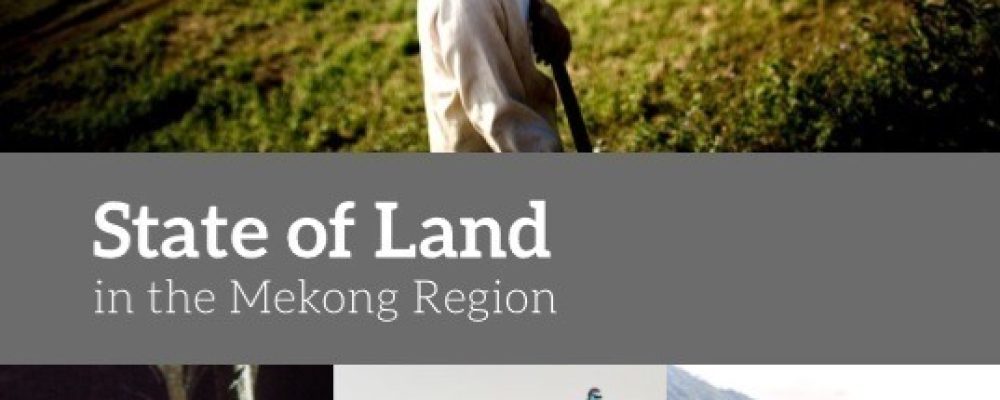Vientiane, 13 March 2019
The report “State of Land in the Mekong Region” was launched today in Vientiane, Lao PDR. The first publication of its kind in the Mekong Region, it brings together key data and information on the current status of, and changes in, land resources, their social distribution, and the conditions of governance that shape them. The report stresses the need for urgent action towards transformational change. It was co-produced by the Centre for Development and Environment (CDE) of the University of Bern and the Mekong Region Land Governance Project (MRLG). Funding was provided by Switzerland, Germany, and Luxembourg.
The Mekong region – Cambodia, Lao PDR, Myanmar, Thailand, and Vietnam – is in the midst of profound social and environmental change. Despite rapid urbanization, the region remains predominantly rural. More than 60 per cent of its population live in rural areas, and the vast majority of these people are engaged in agriculture.
Due to rapid growth of its agricultural sector, the Mekong region has become a global centre of production and trade for commodities such as rubber, rice, cassava, wood, sugar cane, and palm oil. Between 1996 and 2015, overall agricultural land in the Mekong region grew by 20 per cent, or around 9 million hectares. Most of this expansion has occurred at the expense of the region’s natural capital – especially forests and other vegetation.
The Mekong region at a tipping point?
While accelerated flows of global investment and the trade of land-intensive commodities have contributed to economic growth, the outcomes have been highly unequal: The benefits of development have largely accrued to the urban elite, while costs have largely been borne by the rural poor. Rural land relations are changing fundamentally, creating new insecurities for land tenure. The Mekong region may well be at a tipping point. Transformational change is crucial to sustainably address the needs of smallholders.
Data and information are a key prerequisite for understanding ongoing changes, informing more equitable and innovative decision-making, and monitoring the outcomes of decisions made. “State of Land in the Mekong Region” highlights key trends and changes in the Mekong region that dominate current land debates. In addition, it reflects on how these regional issues relate to global change processes. The report features contributions from world-leading experts from Asia, Europe, and the United States.
“Forerunner and model for similar efforts in other regions of the world”
The report is a co-production of the Centre for Development and Environment (CDE) of the University of Bern and the Mekong Region Land Governance Project (MRLG). Funding was provided by the Swiss Agency for Development and Cooperation (SDC), the German Federal Ministry for Economic Cooperation and Development (BMZ), and the Government of Luxembourg.
Peter Messerli, Director of CDE at the University of Bern, hopes “that the report will promote further dialogue around the complex issues we face today, and also that it will be a forerunner and model for similar efforts in other regions of the world.”
Ivo Sieber, Swiss Ambassador to Thailand, states: “The State of Land in the Mekong Region” is the first publication of its kind in this region, and an invaluable asset for donors, development organizations and government agencies as we work together toward the achievement of the Sustainable Development Goals under Agenda 2030. In particular, it provides a robust basis of information and analysis to support the needs of smallholder farmers and rural communities as they grapple with the complex challenges facing them today. Switzerland recognizes the essential role that land plays in the development of the Mekong Region. We are proud to contribute to the identification and analysis of key issues revolving around land in the Mekong State of Land report.”
CONTACT
- CDE Lao Country Office: Micah Ingalls, [email protected], +856 20 599 217 28
- MRLG Project: Jean-Christophe Diepart, [email protected], Phone number, +855 12 598402
PHOTOS
Please note that the photos in the Download section are exclusively for use in reporting on the publication of “State of Land in the Mekong Region”, and the photographer must be credited.
Publications are available here:
- State of Land in the Mekong Region – Full report
- State of Land in the Mekong Region- Brief
- High resolution view on issuu
Highlight Summaries in the main languages of the Mekong Region:
- State of Land in the Mekong Region- Highlights (Burmese)
- State of Land in the Mekong Region- Highlights (Khmer)
- State of Land in the Mekong Region- Highlights (Lao)
- State of Land in the Mekong Region- Highlights (Thai)
- State of Land in the Mekong Region- Highlights (Vietnamese)

